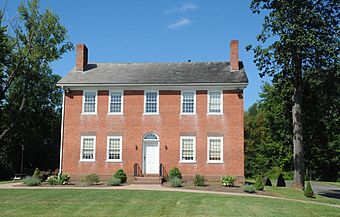Jacob Pledger House facts for kids
The Jacob Pledger House is a special old building in Middletown, Connecticut. It was built way back in 1803. This house is important because it's one of only five brick houses in Middletown built in the "Federal style."
The Federal style was popular in the United States from about 1780 to 1830. It often features simple, balanced designs. Because of its history and unique style, the Jacob Pledger House was added to the National Register of Historic Places in 1982. This means it's recognized as a very important historical site. Today, the house is used for offices.
Contents
What Does It Look Like?
The Jacob Pledger House is in the northern part of Middletown. You can find it on the west side of Newfield Street, where it meets La Rosa Lane.
Outside the House
This house is made of red brick and has two and a half stories. It has a pointed roof, called a gabled roof, with chimneys at each end. The front of the house has five sections with windows that are placed evenly. The main door is right in the middle.
The windows on the first floor have special brown stone pieces above them, called lintels. The front door also has a cool half-circle window above it, known as a transom window.
Inside the House
When you go inside, you can still see many of the original parts of the house. One of the most interesting features is the beautiful wooden staircase. It has detailed carvings that show how skilled the builders were.
A Look at Its History
The Jacob Pledger House was built in 1803 by a man named Jacob Pledger. He was an immigrant from England. Jacob Pledger worked as an agent for a local brewery.
The Land and Its Owners
The house was built on a large piece of land, about 80 acres, that originally belonged to Jacob Pledger's father-in-law. Newfield Street actually cut through the middle of this land. For many years, the property was used for farming.
Jacob Pledger sold the house and land in 1813 to Samuel Miller. The Miller family kept the property for a very long time, until 1953.
Protecting History
In 1953, the city bought the property to develop the area. However, when the city sold the house later, they made sure to include rules. These rules were put in place to protect the house's special historic features. This helped make sure the Jacob Pledger House would be preserved for future generations.




